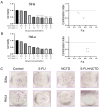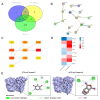Norcantharidin Enhances the Antitumor Effect of 5-Fluorouracil by Inducing Apoptosis of Cervical Cancer Cells: Network Pharmacology, Molecular Docking, and Experimental Validation
- PMID: 38785510
- PMCID: PMC11120450
- DOI: 10.3390/cimb46050242
Norcantharidin Enhances the Antitumor Effect of 5-Fluorouracil by Inducing Apoptosis of Cervical Cancer Cells: Network Pharmacology, Molecular Docking, and Experimental Validation
Abstract
The high recurrence rate of cervical cancer is a leading cause of cancer deaths in women. 5-Fluorouracil (5-FU) is an antitumor drug used to treat many types of cancer, but its diminishing effectiveness and side effects limit its use. Norcantharidin (NCTD), a demethylated derivative of cantharidin, exhibits various biological activities. Here, we investigated whether NCTD could potentiate 5-FU to induce cervical cancer cell death. To assess the cell viability and synergistic effects of the drugs, cell counting kit-8 and colony formation assays were performed using HR-HPV-positive cervical cancer cell lines. Annexin V-FITC/PI staining and TUNEL assays were performed to confirm the induction of apoptosis. The synergistic effect of NCTD on the antitumor activity of 5-FU was analyzed using network pharmacology, molecular docking, and molecular dynamics simulations. Apoptosis-related proteins were examined using immunoblotting. The combination of NCTD and 5-FU was synergistic in cervical cancer cell lines. Network pharmacological analysis identified 10 common targets of NCTD and 5-FU for cervical cancer treatment. Molecular docking showed the strong binding affinity of both compounds with CA12, CASP9, and PTGS1. Molecular dynamics simulations showed that the complex system of both drugs with caspase-9 could be in a stable state. NCTD enhanced 5-FU-mediated cytotoxicity by activating apoptosis-related proteins. NCTD acts synergistically with 5-FU to inhibit cervical cancer cell proliferation. NCTD enhances 5-FU-induced apoptosis in cervical cancer cell lines via the caspase-dependent pathway.
Keywords: HPV-positive; bioactivity; cancer; nature product; network pharmacology; synergism.
Conflict of interest statement
The authors declare no conflicts of interest.
Figures





Similar articles
-
Effector mechanisms of norcantharidin-induced mitotic arrest and apoptosis in human hepatoma cells.Int J Cancer. 2002 Jul 10;100(2):158-65. doi: 10.1002/ijc.10479. Int J Cancer. 2002. PMID: 12115564
-
[Effects of norcantharidin on angiogenesis of human gallbladder carcinoma and its anti-angiogenic mechanisms].Zhonghua Yi Xue Za Zhi. 2006 Mar 14;86(10):693-9. Zhonghua Yi Xue Za Zhi. 2006. PMID: 16681930 Chinese.
-
Norcantharidin induces mitochondrial-dependent apoptosis through Mcl-1 inhibition in human prostate cancer cells.Biochim Biophys Acta Mol Cell Res. 2017 Oct;1864(10):1867-1876. doi: 10.1016/j.bbamcr.2017.07.015. Epub 2017 Jul 29. Biochim Biophys Acta Mol Cell Res. 2017. PMID: 28760656
-
Norcantharidin: research advances in pharmaceutical activities and derivatives in recent years.Biomed Pharmacother. 2020 Nov;131:110755. doi: 10.1016/j.biopha.2020.110755. Epub 2020 Sep 25. Biomed Pharmacother. 2020. PMID: 33152920 Review.
-
Strategies for Solubility and Bioavailability Enhancement and Toxicity Reduction of Norcantharidin.Molecules. 2022 Nov 10;27(22):7740. doi: 10.3390/molecules27227740. Molecules. 2022. PMID: 36431851 Free PMC article. Review.
Cited by
-
Drugs and drug targets for the treatment of HPV-positive cervical cancer.Tumour Virus Res. 2025 Jun;19:200309. doi: 10.1016/j.tvr.2024.200309. Epub 2024 Dec 19. Tumour Virus Res. 2025. PMID: 39709045 Free PMC article. Review.
-
Construction of Dynamic Hydrogel Inducing Effective and Selective 5-Fluorouracil Monotherapy against Cervical Cancer Cells.ACS Appl Mater Interfaces. 2025 Mar 5;17(9):13427-13444. doi: 10.1021/acsami.4c20276. Epub 2025 Feb 21. ACS Appl Mater Interfaces. 2025. PMID: 39982379 Free PMC article.
References
LinkOut - more resources
Full Text Sources
Research Materials
Miscellaneous

